WRASTLING
Curse of the Iron Claw: the tragic, stranger-than-fiction saga of (U$) wrestling’s first familyTom Fordy
Sat, 30 December 2023
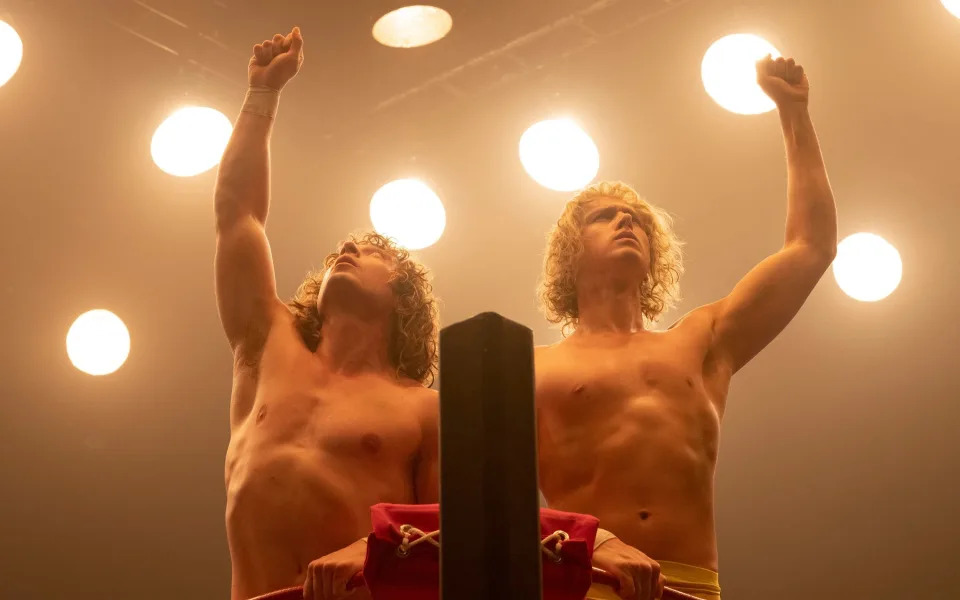
Jeremy Allen White, left, and Harris Dickinson in a scene from The Iron Claw - Brian Roedel
On February 18 1993, Fritz Von Erich – a legendary wrestling star and promoter – found the body of his own son, Kerry Von Erich, on his ranch in Denton County, Texas. Kerry, 33, was sitting upright against a tree. He’d shot himself through the heart with his father’s own .44 – a grisly suicide that still haunts professional wrestling lore three decades later. Kerry was the fifth of Fritz’s sons to die – and the third to die by suicide. “Dad found him and said he’d never seen such a peaceful look on Kerry’s face,” recalled the only surviving Von Erich brother, Kevin. “It must have hit him just right.”
In the early 1980s, Kerry Von Erich had been one of the biggest wrestling stars in the United States, often teaming alongside brothers David and Kevin in their father’s Dallas-based promotion, World Class Championship Wrestling (WCCW). The promotion revolutionised wrestling TV and made rock star-like heroes of the boys. But Kerry lost his brothers one-by-one and had his right foot covertly amputated – a secret later exposed in a macabre moment in the ring. And by the time he took his own life, Kerry Von Erich – also known as “The Texas Tornado” – was facing prison on drug charges.
The story of the Von Erich family – the subject of the new Zac Efron-starring wrestling biopic, The Iron Claw – is both horribly tragic and bizarre. In fact, the fate that befell Fritz, the wrestling Nazi-turned-all-American born-again Christian, and his brood of heartthrob sons, is almost too sad for one film.
The Von Erich “curse”, as it’s often called, is like a warning from a time when the wrestling business was booming, but also awash with steroids, cocaine, and painkillers – an epidemic born from the punishing, cutthroat demands of the pretend sport, in which the grip on reality is deliberately, sometimes perilously loose. Wrestlers all too easily loose themselves in the characters and storylines they peddle to sell not just tickets but their own mystique. Dave Meltzer, a wrestling journalist in the US, previously described how the Von Erichs lived in a “fantasy”.
Fritz Von Erich was not really a Nazi – or even German – though he’s often painted as the abusive, self-serving villain in the Von Erich story. Real name Jack Adkisson, he was a 6’3”, 275lb Texan who sold punters on a series of untruths: that he was the greatest wrestler who ever lived; that his trademark hold, the Iron Claw – a vice-like grip on opponents’ faces – was both agonising and unbreakable; and that his all-American athlete sons were pure-hearted, do-no-wrong, clean-living heroes.
He pushed his teenage offspring into tough workout schedules, punished them with a leather strap, and blatantly picked favourites. He marketed them as something that – in some cases – they couldn’t live up to and stooped to cashing-in on their deaths. Fritz may have sold himself on the biggest lie of all: denial about his sons’ drug problems.
For the Von Erichs, wrestling – and the pain that came with it – was almost a destiny. As surviving brother said Kevin in a 2006 documentary: “We got into wrestling because we wanted to be like our dad.”
Fritz – or Jack as he was then – had been a football player before learning to wrestle under Stu Hart, the patriarch of troubled wrestling dynasty the Hart family (members include Owen Hart, who died in the middle of a WWF ring after he plummeted 80ft from the rafters in a botched stunt, and “The British Bulldog” Davey Boy Smith, who died aged 40 after years of drug and steroid abuse). Adkisson created the character of Fritz Von Erich, a Nazi “heel” (wrestling parlance for the baddie). German, Japanese, and Russian heel characters were commonplace in the post-war period. Fans – called “marks” within the clandestine inner workings of wrestling – would pay to see the good guys, or “babyfaces”, defeat the dastardly foreigners.
In the 1960s, Fritz was an international wrestling star – one of the biggest drawing heels in both the US and Japan. But tragedy had already struck Fritz and his wife, Doris. In 1959, their six-year-old son, Jackie, was electrocuted by an exposed wire and drowned in a puddle
.
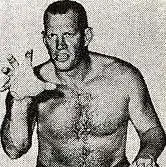
Fritz Von Erich in 1976
From the mid-1960s, Fritz ran his own Texas wrestling promotion, Big Time Wrestling, which was later renamed World Class Championship Wrestling. Fritz made himself the top star, transitioning into a babyface hero (unusual for a Nazi) with an all-American family image. He later found God, although cynics would say it was another crafty promotional tactic.
At that time, the American wrestling business was divided into “territories” – regional promotions connected by a governing body, the National Wrestling Alliance (NWA). The NWA would select a world champion, who would travel between the territories to defend the title against the most popular local stars. Fritz was never NWA world champion, though he became NWA president and boasted that his sons – Kevin, David, and Kerry – were all future champions.
Kevin, David, and Kerry were all-star athletes at high school. Kerry – real name Kerry Gene Adkisson, the youngest of the three – was the most accomplished. He was a high school football player and discus-throwing champion. As reported by Dave Meltzer at the time of his death, Kerry was rumoured to be heavily enhanced by steroids by the 10th grade – aged 15-16. Attempts to carve their own paths were futile; even the teachers called the Adkisson boys “Von Erich”.
They were undeniable talents in the ring. Kevin (played by Zac Efron in the film) wrestled barefoot and dazzled fans with his aerial assaults. David (Harris Dickinson) was an instinctively skilled, highly charismatic grappler. And Kerry (The Bear’s Jeremy Allen White) was a raw athlete with an Adonis-like physique and known as “the Modern Day Warrior”.

Fritz Von Erich in 1976
From the mid-1960s, Fritz ran his own Texas wrestling promotion, Big Time Wrestling, which was later renamed World Class Championship Wrestling. Fritz made himself the top star, transitioning into a babyface hero (unusual for a Nazi) with an all-American family image. He later found God, although cynics would say it was another crafty promotional tactic.
At that time, the American wrestling business was divided into “territories” – regional promotions connected by a governing body, the National Wrestling Alliance (NWA). The NWA would select a world champion, who would travel between the territories to defend the title against the most popular local stars. Fritz was never NWA world champion, though he became NWA president and boasted that his sons – Kevin, David, and Kerry – were all future champions.
Kevin, David, and Kerry were all-star athletes at high school. Kerry – real name Kerry Gene Adkisson, the youngest of the three – was the most accomplished. He was a high school football player and discus-throwing champion. As reported by Dave Meltzer at the time of his death, Kerry was rumoured to be heavily enhanced by steroids by the 10th grade – aged 15-16. Attempts to carve their own paths were futile; even the teachers called the Adkisson boys “Von Erich”.
They were undeniable talents in the ring. Kevin (played by Zac Efron in the film) wrestled barefoot and dazzled fans with his aerial assaults. David (Harris Dickinson) was an instinctively skilled, highly charismatic grappler. And Kerry (The Bear’s Jeremy Allen White) was a raw athlete with an Adonis-like physique and known as “the Modern Day Warrior”.
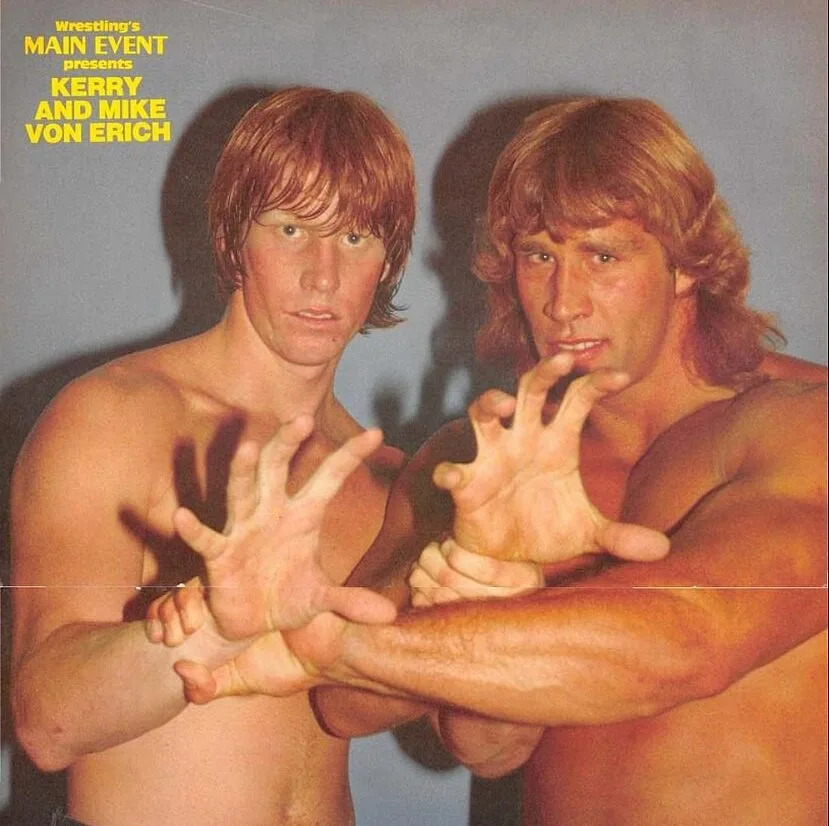
Kerry and Mike von Erich in 1984
Sold to Texas wrestling fans as wholesome studs, the Von Erich brothers became legitimate superstars. They have huge success in a “feud” – a storyline rivalry and series of matches – with a three-man team known as the Fabulous Freebirds, led by a Confederate flag-wearing showboat named Michael PS Hayes. The Von Erichs vs Fabulous Freebirds business was, to use more wrestling parlance, hot. They sold out the Dallas Sportatorium week after week, while thousands were turned away from packed out arena shows. The Von Erich boys also wrestled the NWA world champion, Ric Flair, a flamboyant, platinum-dyed playboy who’s often called the greatest wrestler of all time.
Locally, the Von Erichs were folk heroes. Their rock star status drove girls wild. Kerry in particular, wrote Meltzer, was “the object of desire for every female in the state of Texas, and plenty in other states as well”. The Von Erichs, forever selling themselves to the marks – something that came from growing up in the carny-like wrestling biz – pretended they were single to keep the ladies happy.
The weekly WCCW shows also changed how wrestling was presented on television. Multi-camera set-ups put viewers right in action, while wrestlers entered the arenas to the sound of rock music – all now standard fare in wrestling. In a 2006 documentary, Heroes of World Class Wrestling, the producer admitted that the programmes were inspired by the Rocky movies.
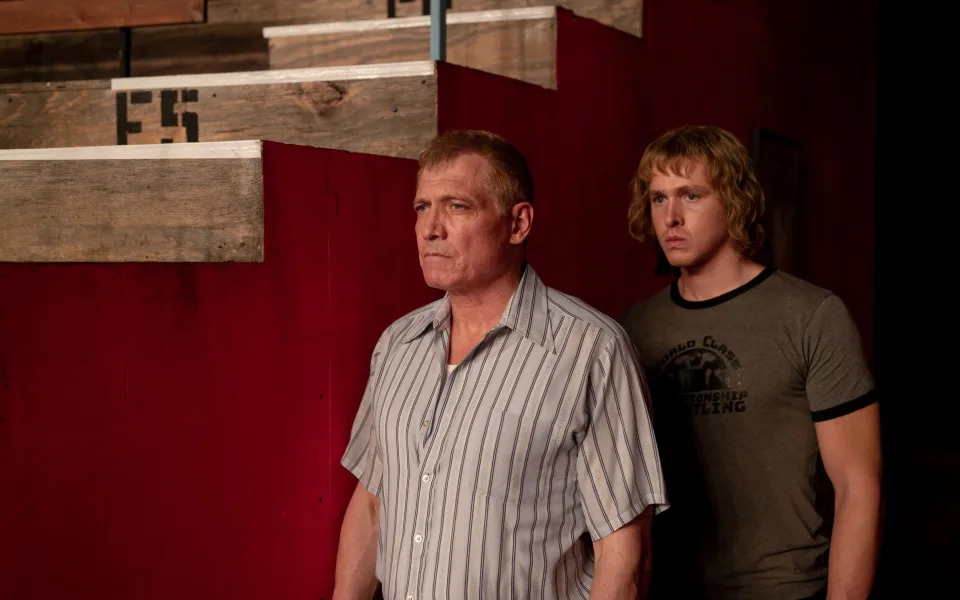
Holt McCallany and Harrison Dickinson as Fritz and David Von Erich in The White Claw - Brian Roedel
The WCCW shows were syndicated and made the Von Erichs national stars. Kerry wrestled sell-outs against Flair around the country, while their TV shows reached as far as Japan, Europe, and the Middle East. From 1982 to 1984, WCCW was the most popular wrestling promotion in the world.
The Von Erichs appeared on magazine covers. They starred in their own comic book and featured on pizza commercials. Kerry even had a hotline number that fans – particularly female fans – could call to ask him anything. “I mean anything,” Kerry reiterated in the TV commercial.
In Texas, the Von Erichs’ reputation was so god-like that when Kerry was busted at Dallas Fort Worth Airport in 1983 – carrying an assortment of downers, powders, and marijuana – it barely made a dent in their reputations. This was long before wrestling had admitted to fans that it was in fact fictitious. As Meltzer noted, hardcore fans bought into the wrestling storylines so much that they dismissed the scandal and believed that the Von Erichs’ sworn enemy, Michael PS Hayes, must have somehow planted the drugs on Kerry. The evidence mysteriously disappeared from the police station.
Behind the scenes, there were stories about the Von Erichs’ drug use. Fritz told them never to drink in public, though the boys caused problems with local merchants and sponsors by turning up for public appearances in various states – if they turned up at all. Fritz refused to believe it.
Initially, it was David Von Erich who was tipped to be the biggest star of the three and the future NWA world champion. So in February 1984, David –whose baby daughter had died of SIDS at 13 weeks old – embarked on a wrestling tour of Japan. Before wrestling a single match, he was found dead in his hotel room. A common story within wrestling is that David died from an overdose of Placidyls, a sedative, and that fellow wrestler Bruiser Brody flushed the pills down the toilet when he found the body (Bruiser Brody met an untimely end himself – he was murdered in a Puerto Rico locker room in 1988). The official cause of David’s death, however – and the version depicted in the movie – was acute enteritis, a swelling of the intestines. It’s true that he was visibly ill before his death.
David Manning, a referee and backstage figure with WCCW, got the call from Japan and drove to Fritz’s ranch in the early hours to break the bad news. When Fritz saw him pulling up, he came out and asked, “Which one?”
A reported 3,000 fans attended David’s funeral. Fritz – not one to miss a trick – had a cash-in song, Heaven Needed a Champion, quickly recorded in his son’s honour. Fritz promoted a David memorial show at Texas Stadium, just outside of Dallas, which drew over 32,000 fans and made $400,000-plus at the gate – the second biggest gate in US wrestling history at the time.
Fans expressed their grief by snapping up copies of the record – performed live at the event – and overpriced David Von Erich memorabilia. In the headline match, Kerry finally defeated Ric Flair for the NWA world championship, winning the title in his brother’s honour. Kerry’s championship reign was short-lived – he lost the title back to Flair less than three weeks later.
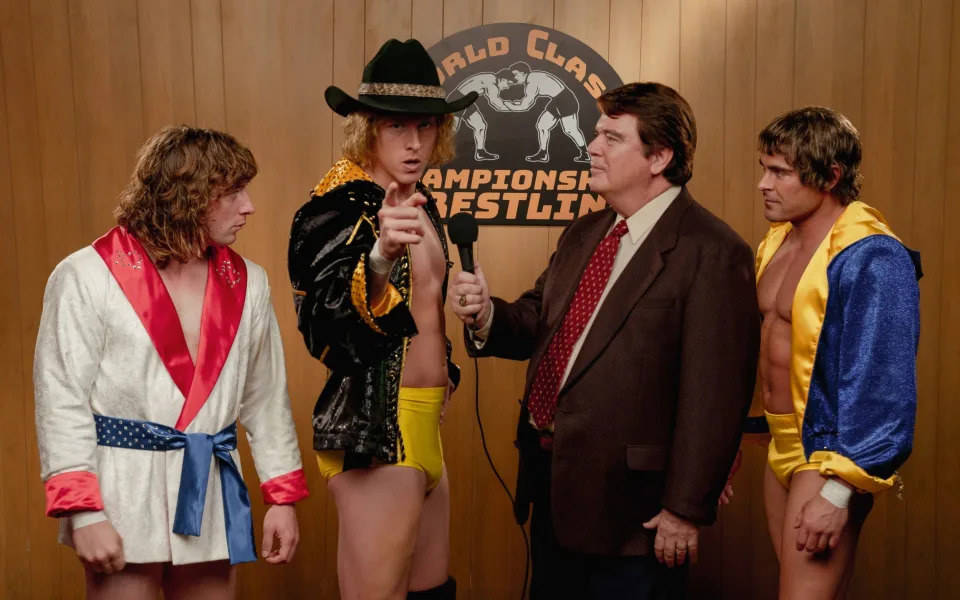
A scene from The Iron Claw
A fourth brother, Mike Von Erich (Stanley Simons in the movie), had debuted shortly before and was tasked with replacing David. But Mike – who did look like David – struggled with the pressure, and was not a naturally gifted wrestler like his brothers. “The only thing he had going for him is that he was called Mike Von Erich,” said Dave Meltzer on Viceland’s Dark Side of the Ring documentary. After dislocating his shoulder, Mike required surgery and contracted bacterial staph infection. Spiking a fever of 107 – at which point his organs began to shut down – Mike almost died from toxic shock syndrome.
Fritz, believing he needed another Von Erich, invented a pretend cousin, “Lance Von Erich” – actually a not-especially-good wrestler named William Kevin Vaughan. “Lance”, promoted as part of the family, soon fell out with Fritz over money and jumped to a rival promotion. The deception, which some fans suspected from the start, was a blow to the Von Erichs’ image and integrity.
In the mid-1980s, the New York-based World Wrestling Federation (WWF) – now WWE – began an aggressive national expansion. With Hulk Hogan as its biggest star name, the WWF stormed into other territories to take their TV slots, muscle into their business, and poach their best wrestlers. Loyalty to the Von Erichs held firm in Texas at first, but WCCW’s popularity ultimately declined.
In June 1986, Kerry crashed his motorbike. Speeding without a helmet or even shoes, he ploughed into a parked police car, suffering a dislocated hip, internal injuries, and a mangled right leg. Doctors performed microsurgery to save his foot, which one witness said looked like “an alligator had chewed on it”.
With business on the slide, Fritz advertised Kerry’s return to the wrestling ring just eight months later. Kerry got through the match after being pumped full of novocaine, but reinjured the ankle. Only 2,326 fans paid to – a far cry from the 32,000-plus who once paid to see him beat Ric Flair. At some point, his foot was amputated, though he continued wrestling with a prosthetic – a tightly guarded secret and later the stuff of wrestling legend. “He wanted me to promise to hide that… he was ashamed of it,” said brother Kevin on Dark Side of the Ring.
To hide the missing foot, Kerry would shower after matches with his boot on; other wrestlers put down to eccentricity. But the secret was exposed during a match, when Kerry’s opponent – a character known as Colonel DeBeers – grabbed Kerry’s foot for a hold and accidentally yanked his boot off. The audience was stunned by the sight of Kerry’s foot-less stump beneath.
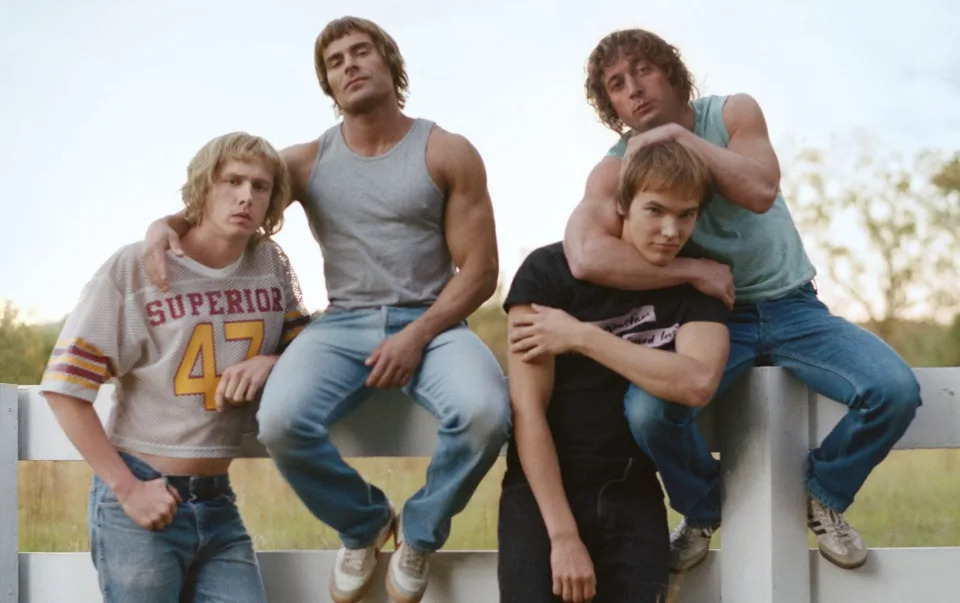
The Von Erich brothers, as seen in The Iron Claw
Mike, meanwhile, never fully recovered from the toxic shock – physically or mentally. After a near-miss car crash and series of arrests, he went to Lewisville Lake in April 1987 and overdosed on Placidyls. He was just 23. The drug problems were not exclusive to the Von Erichs in WCCW. The year before, Gino Hernandez, a top heel for the company, died from a cocaine overdose.
On Christmas Day 1987, Fritz pulled out his most underhanded tactic yet. In a wrestling “angle” – a storyline incident designed to build hype for a show – Fritz was supposedly attacked by the Freebirds and feigned a heart attack, playing on the fans’ sympathy and very real heartbreak over his dead sons. As remembered by Dave Meltzer, TV broadcasts would update viewers each week on Fritz’s condition. If the arena did good box office that week, he’d show improvement; if there were still empty seats, his condition would worsen.
In 1988, D Magazine published a profile on the Von Erichs, which explored their tragedies so far. Kevin, talking about the allure of wrestling itself, gave a quote that now seems chilling. “I guess this is our destiny,” Kevin said, “and there’s nothing more to be said about it. You have to go where your destiny leads you, no matter where that road might be. And for us, this is it.”
A few years later, the youngest brother, Chris Von Erich – who is omitted from the movie completely – also took his own life. Chris had been severely asthmatic and took medication that left him with brittle bones. He idolised his brothers but didn’t have the physical aptitude for professional wrestling. He broke his arm – another setback as he failed to live up to the Von Erich name. In September 1991, aged just 21, he shot himself in the head.
By that time, Kerry had joined the WWF, which had all but eradicated the old wrestling territories. Entering the WWF with some fanfare, he was renamed “The Texas Tornado” and quickly won the WWF’s Intercontinental Championship. But Kerry – not the performer he’d once been and addicted to painkillers – slipped down the rankings. The WWF was on the cusp of its own drugs scandal – particularly steroid use among its wrestlers – and the company would soon purge its locker room of steroids and the most obvious steroid users.
After a stint at the Betty Ford clinic, Kerry was the first wrestler to speak openly about getting treatment for his addictions (Hulk Hogan, conversely, went on a TV chat show and unashamedly lied about using steroids). But Kerry – remembered by those who knew him as soft-hearted and generous – also talked about suicide. Fellow WWF wrestler Bret Hart – the biggest star from the Hart wrestling dynasty – recalled how Kerry had made up his mind to “join his brothers in heaven”.
Kerry was let go from the WWF in the summer of 1992. Already serving a 10-year probation for forging drug prescriptions, he was arrested in January 1993 for cocaine possession and indicted on February 17. Financially broke and with his marriage on the rocks, Kerry was very likely going to prison. The following day, Kerry Adkisson – the Modern Day Warrior – went to Fritz’s ranch, told his father he loved him, and went outside to end his own life.
Wrestling personality Gary Hart, who played a pivotal role in the peak of WCCW, wrote in his autobiography about how the Von Erichs’ mother, Doris, would visit his office. When she left, she would touch a photo of her sons and weep.
The “curse” of the Von Erichs is as much a fiction as any story that Fritz used to sell tickets. It was, more realistically, a cycle of copycat suicides – a sad, inescapable pattern – arguably enabled by Fritz memorialising his dead sons as American heroes. Bret Hart wondered if the Von Erichs were so competitive that killing themselves was “the ultimate act of bravado”.
Later, when Fritz was suffering from brain cancer, he held a gun to Kevin and said, “You’d kill yourself too if you have the guts.” Kevin – who relayed the story on Dark Side of the Ring – replied, “Dad, it takes guts to live, not guts to die.” Fritz himself died in 1997.
Kevin Von Erich has since summed up the story with an often repeated line. “I used to have five brothers,” he said. “Now I’m not even a brother.”
The Iron Claw is in US cinemas now and will be released in the UK on February 24
No comments:
Post a Comment